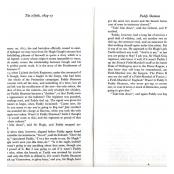'Appearing at the Halberds' - Flogging.

|
| The last cat o'nine tails used in the 83rd Regiment. |
Prior to 1812, the 'Articles of War', known to soldiers as 'the Devil's Article', was the legislation which enabled regimental courts martial to hand down punishments without limitation for offences such as - an action which was 'to the prejudice of good order and military discipline'; 1,900 lashes appears to be the maximum ever recorded.
The cat-o'-nine-tails as used in the British Army was originally made from a drumstick with nine cords tied to it, each cord having a knot at the end. The court martial's sentence was supervised by the Adjutant and carried out by the Drum Major and the Drummers of the regiment. The prisoner was tied by his extended arms to a horizontal halberd* across two or three halberds anchored in the ground and formed into a triangle. A drum beat tapped out the lash in slow time and after twenty-five lashes the task was passed to the next drummer. The regimental surgeon was usually present to halt the punishment when it was unsafe to continue or if the man fainted. Also present was a team of stretcher bearers from the regiment's hospital. They would carry the prisoner to hospital where he would recover until fit enough to endure the balance of his sentence or be returned to duty. Unfortunately this punishment was much abused and it was not uncommon for some commanding officers to inflict 500 to 1,000 lashes.
When the Mutiny Act was brought before Parliament in 1811, a new clause was introduced which empowered courts martial to imprison instead of inflicting the old established punishment of flogging. In 1812, the Adjutant General sent a confidential circular to officers commanding regiments on behalf of the Commander-in-Chief of the Army, HRH The Duke of York, and made clear the limitations:
of regimental courts martial to the purposes for which enabling legislation so limited them, viz, for enquiring into such disputes or criminal matters as may come before them, and for inflicting corporal or other punishments for small offences, and in order to prevent any misunderstanding on this important point, it is His Royal Highness’s command, that on no pretence whatever shall the award of a regimental court-martial hereafter exceed 300 lashes.
Reforms of the British Army in 1868, included the abolition of flogging as a punishment in peacetime and reserving it as a punishment for use on active service only until, finally in 1888, it was abolished entirely. Below, a record of such punishments and the tale of Private Paddy Shannon from the history of The Royal Irish Fusiliers.
*
Correctly known as a ‘spontoon’ it was issued to infantry colour sergeants who would use it horizontally along men’s’ backs to encourage straight lines in the ranks, especially when in ‘squares’ and when the colour sergeants were called to guard the Colours. Also referred to as a ‘pike’, it ceased to be issued to the infantry from 1830.







